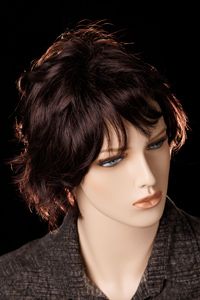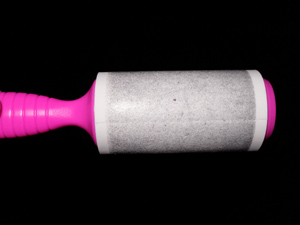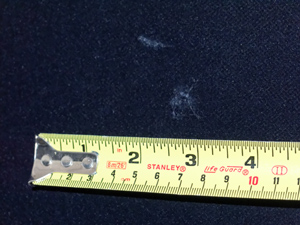RomaPhoto Velvetlike Velour 6x9 ft Jet Black Background Backdrop by DMKFoto — Review
© 2013 Peter Free
11 June 2013

Surprisingly good — but with some negatives that may be deal-breakers for photographers, who use multiple backgrounds each day or week
For the money, this is a good backdrop. But its noticeable stiffness and lint-gathering work against it in studios that require multiple background changes each day.
First — what this is
EBay’s “RomaPhoto Velvetlike Velour 6x9 ft Jet Black Background” is actually distributed by DMKFoto.com.
Note
When you get your receipt the business addresses match each other and, in my case, two coupons from DMKFoto were included.
DMK says:
The velvetlike material is totally non-reflective.
The poly canvas backing gives it body and no folds or wrinkle. This is the best of both world[s].
It makes it easy to control the result of the background.
© 2013 DMKFoto, 6x9 Velvetlike / Velour Jet Black Background, DMKFoto.com (visited 11 June 2013) (paragraph split)
RomaPhoto adds:
This chromakey black backdrop lets the photographer easily separate the model's image from the background and transplant it onto other preferred background (natural or backdrop) at a later day.
This is a very versatile background. You can create hundreds of different effects by transplanting your image into thousand[s] of different backgrounds in just a minute.
© 2013 RomaPhoto, RomaPhoto Velvetlike / Velour 6x9 ft Jet Black Background Backdrop New, eBay.com (visited 11 June 2013)
Negatives begin to creep in
Negatives include:
(1) RomaPhoto’s erroneous statement about chromakey utility
(2) Erroneous attribution of “no fold or wrinkle”
(3) Truthful statement about “body” — meaning stiffness
(4) Lint gathering
(5) Absence of a rod pocket
(6) Defects
Negative 1 — misleading statement about chromakey use
The majority of chromakey users do not classify black — or white, the other edition of this background — as chromakey colors. Traditionally, blue and green serve in that capacity. And the majority of chromakey software that I have seen advertised is dependent on those hues.
In reality, using photo processing software like Photoshop, it is quite difficult to separate dark brown or black hair and skin from a black backdrop.
In my opinion, RomaPhoto’s “chromakey” attribution potentially misleads the inexperienced.
Negative 2 — the backdrop is emphatically not wrinkle-free
It comes rolled up and folded in half with a very pronounced vertical crease. This crease, which is dramatically emblazoned down the exact center of the backdrop, has voluminously emanating side branches.
The instructions tell users to fold the crease in the opposite direction to reduce their visual effect.
That’s nonsense. Folding everything the other way just produces more wrinkles.
Instead, I followed the instructions’ suggestion that one use an iron on the back side, with a towel placed between the fabric and the iron.
Even that method is not foolproof. But it does reduce the wrinkling — provided you are careful to keep the excess fabric from wrinkling itself, while you are trying to keep the stiff material from hanging up on everything around the ironing board.
Second, wrinkling also results in ordinary studio use, due to the stiffness of the fabric.
Negative 3 — stiffness
This layered composite is crinkle-sounding stiff.
As a result, it is more challenging than muslin to draw the backdrop up over a cross bar. You will have to work from one end of the bar to the other.
The more you allow the fabric to bunch — as it does naturally because it resists draping the way muslin does — you will hear it crinkle, and you will notice slight wrinkles where it crinkled.
This is not a big deal, except when you have to use multiple backdrops during the course of the same day or week.
I immediately found that changing backgrounds was more annoyingly time consuming that I had hoped.
For example, I use a mannequin to experiment with different lighting setups in my tiny 8 by 9 foot (2.4 by 2.7 meters) “studio”.
“She” sits on a bar stool very close to the background, due to the tiny size of the room. The backdrop is stiff enough to knock “her” off the stool every time I go to change it. So, I have to move the mannequin away from the backdrop, take fabric down, and then try to approximate the position the mannequin was in before I changed everything.
This process quickly becomes tedious and illustrates why professional portraitists are fond of multi-roll background systems.
The problem with changing this relatively stiff backdrop introduces another — lint gathering.
Negative 4 — lint gathering
The compromises necessary to producing a product at this low price point come back to bite the user, who needs to change backdrops frequently.
As RomaPhoto indicates, the product is a composite of a white “poly canvas” (paper-like) back layer and a slightly fuzzy black top layer. Whenever you allow the white to touch the black, bits of the white come off and stick to the black “velour”.
Having the two sides touch is unavoidable when changing backgrounds. Furthermore, the black side will pick up samples of whatever light-colored lint and grit you might have on the floor below it.
One would think that a lint roller would make quick work of the lint. But not so.
Even a quality product like 3M’s Lint Roller picks up way more loose black fuzz than it does white lint. That means that it took me 4 roller sheets to get rid of the specks light-colored lint on this comparatively small 6x9 background.
Note
For people unfamiliar with the 3M Lint Roller, it is basically a roll of edge-perforated separable sheets wound around a roller handle.
When one sheet fills up with crud, you tear it off and a fresh sheet is exposed.
If you assume that you might make 1 or 2 background changes a day (or week), you are going to be using up quite a few lint roller sheets.

Negative 5 — absence of a rod (cross bar) pocket
This will only affect people who want to stick the backdrop on a cross bar:
without using clamps
or
without wrestling with this piece of comparatively large stiff fabric, while running it through a sewing machine.
Negative 6 — defects
My sample of the RomaPhoto backdrop had a couple of lighter colored splotches on its black side, adjacent to where my mannequin was going to sit.

Nevertheless, a good value for the price — if you can live with the backdrop’s drawbacks
RomaPhoto’s claim of low reflectivity is accurate. And that is not an easy quality to engineer into a product at this price.
On the other hand, I found that this somewhat stiff and crinkly, “velvet-like” background is probably more useful semi-permanently left in place, than it is as a regularly alternated background.
 PeteFree.com
PeteFree.com